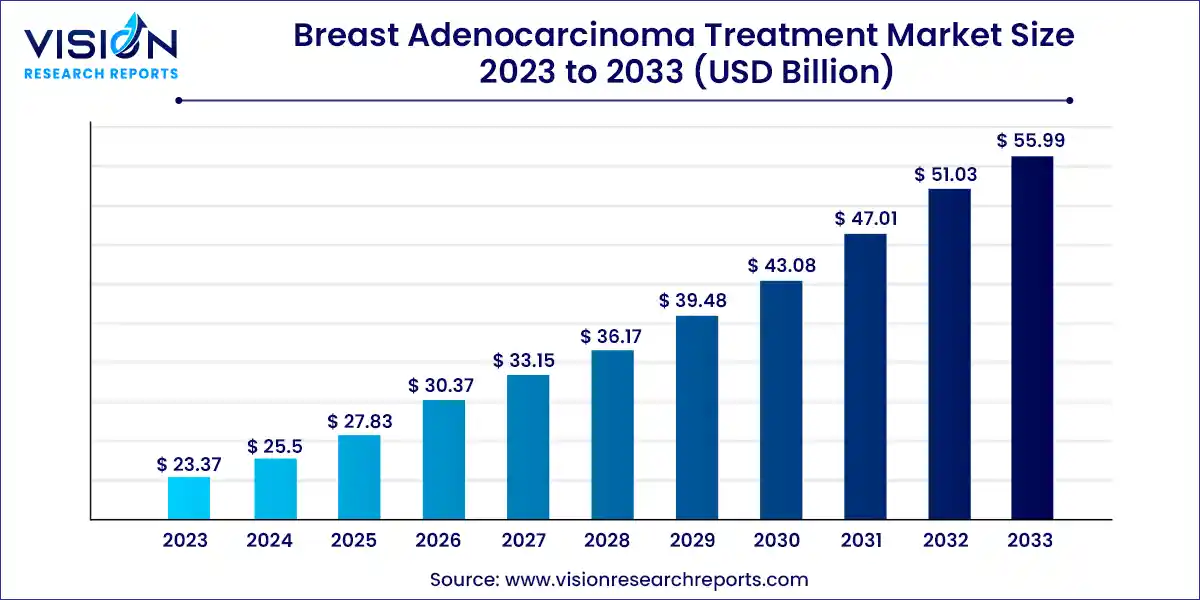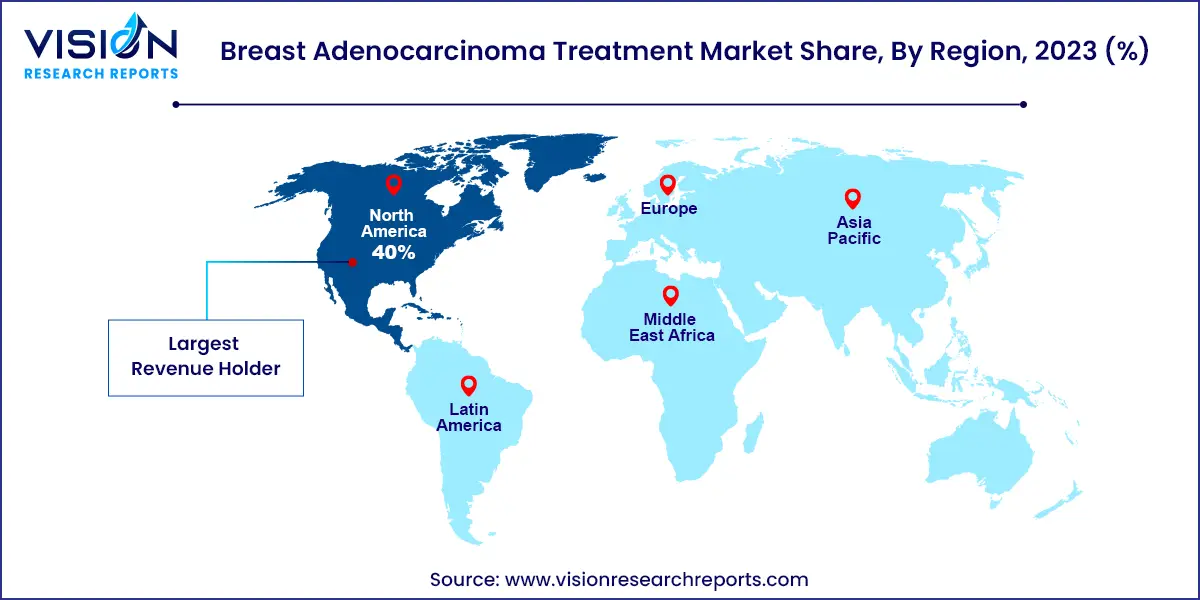The global breast adenocarcinoma treatment market size was estimated at USD 23.37 billion in 2023 and it is expected to surpass around USD 55.99 billion by 2033, poised to grow at a CAGR of 9.13% from 2024 to 2033.

The growth of the breast adenocarcinoma treatment market is significantly driven by an increasing prevalence of breast cancer globally, advancements in treatment methodologies, and growing awareness of early diagnosis. Rising healthcare expenditures and government initiatives to provide better cancer care are also playing a pivotal role in market expansion. Technological innovations, such as targeted therapies and immunotherapies, have enhanced the effectiveness and safety profiles of treatment options, encouraging wider adoption among healthcare providers. Additionally, ongoing research and development efforts focused on personalized medicine are leading to the discovery of novel therapies that are more effective and have fewer side effects, further propelling market growth. Enhanced healthcare infrastructure and access to treatment, particularly in emerging economies, are expected to provide lucrative opportunities for market players, ensuring continued market expansion in the coming years.
In 2023, North America led the global breast adenocarcinoma treatment market, holding the largest revenue share of 40%. The region’s market dominance is attributed to the high prevalence of breast cancer and a well-developed healthcare infrastructure. Significant investments in research and development have facilitated the availability of advanced treatments and early detection methods. The United States remains the largest market in the region, driven by cutting-edge medical facilities, a high incidence of breast cancer, and a strong focus on innovative treatment approaches, including targeted and immunotherapy.
| Attribute | North America |
| Market Value | USD 9.34 Billion |
| Growth Rate | 9.13% CAGR |
| Projected Value | USD 22.39 Billion |
The breast adenocarcinoma treatment market in Europe is expected to experience substantial growth during the forecast period. This growth is driven by factors such as an aging population, increased awareness about breast cancer, and advancements in treatment options. The European Union, along with national health authorities, is actively engaged in enhancing early detection and treatment standards. Key markets like the UK, France, Germany, and Spain are seeing significant progress in precision medicine and targeted therapies.

The breast adenocarcinoma treatment market in the Asia Pacific region is anticipated to grow at a significant CAGR of 9.83% from 2024 to 2033. Factors contributing to this growth include rising cancer incidence rates, improved access to healthcare, and increased awareness about breast cancer. According to the American Cancer Society, breast cancer is the most prevalent cancer among women globally, accounting for 25% of all female cancer cases. In Southeast Asia, breast cancer mortality rates are projected to rise significantly, reaching 61.7% by 2040. This trend highlights the urgent need for enhanced screening, early detection, and effective treatment strategies to address the escalating impact of breast cancer in this region. Countries such as India and China are witnessing robust market expansion due to improved healthcare infrastructure and proactive awareness campaigns. Efforts by regional health organizations and governments to invest in cancer research, early detection initiatives, and treatment advancements are further supporting market growth.
The breast adenocarcinoma treatment market is categorized based on various treatment modalities, including chemotherapy, targeted therapy, hormonal therapy, immunotherapy, radiation therapy, and others. In 2023, targeted therapy accounted for the largest market share of 28%. This dominance highlights the significant role of targeted therapies in revolutionizing breast cancer treatment, shifting towards more precise and effective methods. Unlike traditional chemotherapy, which affects both healthy and cancerous cells, targeted therapy aims at specific molecular markers found in cancer cells. This targeted approach improves therapeutic outcomes by disrupting key pathways that promote tumor growth and survival, while minimizing damage to normal tissues.
Immunotherapy is projected to experience the fastest growth, with a forecasted compound annual growth rate (CAGR) of 12.63% during the forecast period. This rapid growth is fueled by increasing recognition of immunotherapy’s potential, continuous advancements in treatment techniques, and rising investment in research and development. Immunotherapy works by harnessing the body's immune system to fight cancer, marking a significant shift from conventional treatment methods. A study published in December 2023 by the National Library of Medicine confirmed the efficacy of trastuzumab and pertuzumab for both early-stage and advanced HER2-positive breast cancer. Additionally, immune checkpoint inhibitors, such as PD-1/PD-L1 inhibitors, have shown promise, especially in treating subtypes like triple-negative breast cancer (TNBC), where traditional therapies often fall short. The market is also expanding due to the development of innovative treatments like cancer vaccines and CAR-T cell therapies, which enhance the immune system's ability to target and destroy cancer cells.
In 2023, hospitals accounted for the largest share, exceeding 61% of the market. This significant share is primarily due to the high incidence of breast cancer, which drives substantial demand for hospital-based treatments. As one of the most commonly diagnosed cancers worldwide, breast adenocarcinoma requires comprehensive and complex care, making hospitals the main providers of such treatments. Hospitals offer a wide range of services, from advanced diagnostics to surgical interventions, chemotherapy, radiation, and targeted therapies. Their infrastructure and specialized medical teams are essential for managing multifaceted cancer treatments, including combinations of surgery, chemotherapy, and innovative therapies like immunotherapy. Moreover, hospitals often collaborate with academic institutions for clinical trials and research, playing a crucial role in advancing breast cancer treatment and facilitating access to experimental therapies, which supports the movement towards personalized medicine.
Specialty clinics are expected to grow significantly, with a projected CAGR of 10.53%, driven by increased demand for specialized cancer care, advancements in treatment options, and the rise of personalized medicine. These clinics focus exclusively on oncology, providing concentrated expertise and resources for breast cancer diagnosis and treatment, including state-of-the-art therapies and access to advanced clinical trials. Their specialization in novel treatments such as targeted therapies and immunotherapies positions them at the forefront of innovation. With advanced diagnostic capabilities and personalized care approaches, these clinics enhance treatment effectiveness and patient outcomes. Additionally, multidisciplinary teams within these clinics ensure comprehensive care, while expanded insurance coverage and patient-centered services make them more accessible and attractive to patients.
By Treatment
By End Use
By Region
 Cross-segment Market Size and Analysis for
Mentioned Segments
Cross-segment Market Size and Analysis for
Mentioned Segments
 Additional Company Profiles (Upto 5 With No Cost)
Additional Company Profiles (Upto 5 With No Cost)
 Additional Countries (Apart From Mentioned Countries)
Additional Countries (Apart From Mentioned Countries)
 Country/Region-specific Report
Country/Region-specific Report
 Go To Market Strategy
Go To Market Strategy
 Region Specific Market Dynamics
Region Specific Market Dynamics Region Level Market Share
Region Level Market Share Import Export Analysis
Import Export Analysis Production Analysis
Production Analysis Others
Others